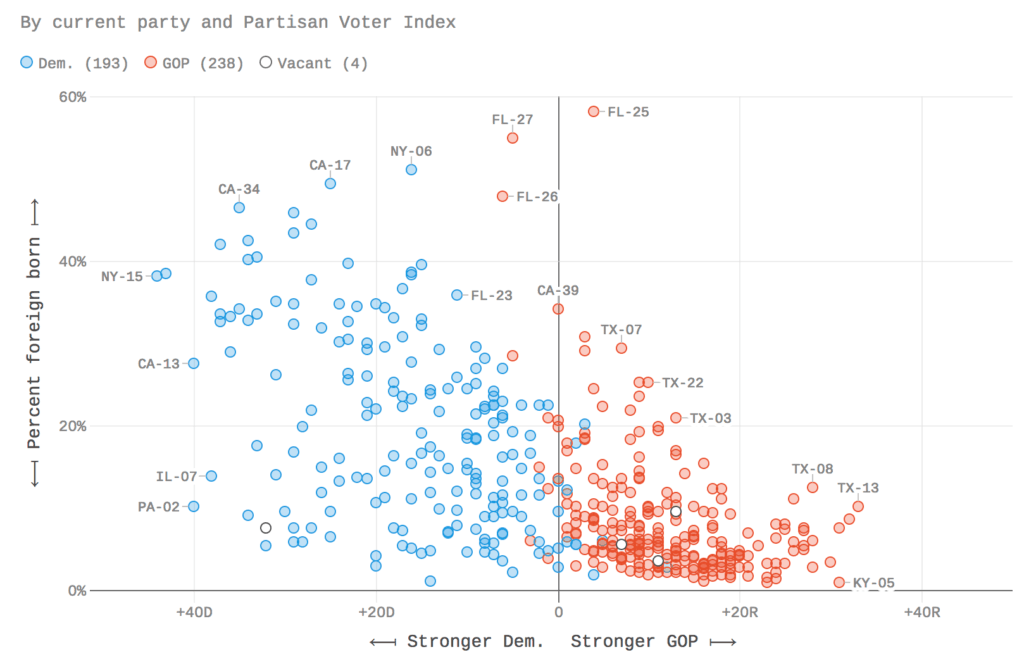Mass Immigration
Mass legal and illegal immigration to the U.S. continues to be the largest driver of population increases and demographic shifts in the country. Every year, more than 1.5 million immigrants are admitted to the country. The U.S. has imported more than ten million immigrants in the last decade.
The vast majority of foreign nationals arrive through the process known as “chain migration,” where newly naturalized citizens can bring an unlimited number of foreign relatives to the U.S. Every two new immigrants to the country bring an additional seven foreign relatives with them.
As Breitbart News has extensively reported, the U.S. is on track to import about 15 million foreign-born voters by the year 2038. That is nearly quadruple the size of the annual number of U.S. births; about four million American babies are born every year.
Through chain migration alone, the U.S. will import about eight million foreign-born voters in the next two decades.
The country’s continued mass immigration policies are likely to hand over electoral dominance to Democrats in statewide and national elections, Breitbart News has noted.
Analysis conducted by Axios’s Chris Canipe and Andrew Witherspoon shows the overwhelming trend of foreign-born populations voting Democrats into office over Republicans.
The victory of socialist Democrat Alexandria Ocasio-Cortez in New York’s 14th District is the latest case where a booming foreign-born voting population pushed the far-left activist over the edge to beat out establishment, high ranking Democrat Rep. Joe Crowley.
Ocasio-Cortez’s district is close to 50 percent foreign-born, a drastic shift of an area that was once populated primarily by native-born Americans. Ocasio-Cortez ran her congressional campaign on abolishing all immigration enforcement across the U.S.
In California, Sen. Dianne Feinstein (D-CA) is facing a challenge from State Senator Kevin de León (D-Los Angeles), and the California Democratic Party has endorsed León. The far-left challenger was the key proponent of California’s sanctuary state law that protects criminal illegal aliens from being deported.
University of Maryland, College Park researcher James Gimpel has found in recent years that more immigrants to the U.S. inevitably means more Democrat voters and thus, increasing electoral victories for the Democratic Party.
In 2014, Gimpel’s research concluded with three major findings:
- Immigrants, particularly Hispanics and Asians, have policy preferences when it comes to the size and scope of government that are more closely aligned with progressives than with conservatives. As a result, survey data show a two-to-one party identification with Democrats over Republicans.
- By increasing income inequality and adding to the low-income population (e.g. immigrants and their minor children account for one-fourth of those in poverty and one-third of the uninsured) immigration likely makes all voters more supportive of redistributive policies championed by Democrats to support disadvantaged populations.
- There is evidence that immigration may cause more Republican-oriented voters to move away from areas of high immigrant settlement leaving behind a more lopsided Democrat majority.
Years ago, only a handful of elected Democrats would mention how the demographic shift spurred by mass immigration was a benefit to Democrats electorally. Today, it is a widely used talking point of elected Democrats.
Take San Antonio, Texas Mayor Julian Castro, for example. Months ago, Castro admitted that immigration could potentially turn the state of Texas, Florida, and Arizona into Democrat strongholds, like California.
“The Democrats have now become very open about what they are doing and they state it very clearly,” Kobach said of the Democrats’ use of immigration for shifting the electorate.
“Now, multiple Democrats are saying their plan is to import new voters to change elections,” Kobach said.
In an analysis from Georgetown University, the University of California, and Banque de France, researchers discovered that immigration to the country continuously increases Democrats’ chances of winning elections:
On average across election types, immigration to the U.S. has a significant and negative impact on the Republican vote share, consistent with the typical view of political analysts in the U.S. [Emphasis added]This average effect – which is driven by elections in the House – works through two main channels. The impact of immigration on Republican votes in the House is negative when the share of naturalized migrants in the voting population increases. Yet, it can be positive when the share of non-citizen migrants out of the population goes up and the size of migration makes it a salient policy issue in voters’ minds. [Emphasis added]These results are consistent with naturalized migrants being less likely to vote for the Republican Party than native voters and with native voters’ political preferences moving towards the Republican Party because of high immigration of non-citizens. This second effect, however, is significant only for very high levels of immigrant presence. [Emphasis added]
In 2016, the legal and illegal immigrant population reached a record high of 44 million. By 2023, the Center for Immigration Studies estimates that the legal and illegal immigrant population of the U.S. will make up nearly 15 percent of the entire U.S. population.
Mexico has the largest group of legal and illegal foreign nationals in the U.S., with 1.1 million immigrants from the country arriving in the U.S. between 2010 and 2016. Mexican nationals make up roughly one in eight new arrivals to the U.S. On average, every one Mexican immigrant brings six foreign relatives with them to the country through chain migration.


No comments:
Post a Comment